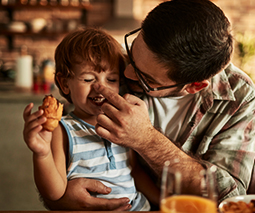10 things parents should know about child car safety


One of our most important roles as a parent is to keep our children safe. But what does that mean when transporting them in the family car? Babyology recently organised a live Q&A with Infasecure’s Chief Car Safety Advocate Tom Hubbard to find out what parents can do to keep their most precious cargo – their kids – safe on car trips. Here are our parents’ top ten questions – and the expert’s top ten tips – for car safety and proper use of child restraints.
1. Where is the safest place for baby to sit in a car?
The safest place for baby to sit is in any correctly fitted child restraint in any spot in the back seat of a passenger car. Of course, collision experts also agree that the middle of the back seat is best in the case of a side collision because it is furtherest from the doors. But parents of multiple children don’t need to wrestle with their consciences about which child to slot where, just make sure all children are correctly restrained in properly fitted child seats because most reputable seats have good in-built side protection.
2. Are parents legally required to have child car seats fitted and installed professionally?
The simple answer is no. Child car seat makers, like Infasecure, provide detailed instructions with all their child restraints and try to design seats that are easy for adults to install themselves. Of course, parents who aren’t confident should find a car seat technician or fitter to help walk them through the process.
3. When should a baby change from a rear-facing car seat to a forward-facing seat?
Legally, babies must be in a rear facing restraint until at least six months, but parents should keep them in rear-facing seats for as long as possible because this protects their fragile necks and torsos from the force of a crash in the event of an accident. Once the child reaches the shoulder height marker on the seat, it’s safe to turn them around.
4. I want to use my car seat for my next baby. When should a child car seat be retired?
Most child car seats should be retired once they reach ten years from the date of manufacture, which is generally stamped on the bottom of the seat. It’s also a good idea to check with the manufacturer to be sure.

5. When will ISOFIX seats go on sale in Australia?
Child car seat manufacturers are still waiting for the Australian Competition and Consumer Commission (ACCC) to mandate the 2013 Standards before ISOFIX seats can be legally sold in this country. That should happen some time this year.
6. Is it safe to use a neck pillow or accessory to prop up a child who falls asleep in their car seat?
No. Safety experts never recommend using these accessories to stop a child’s head falling forward, as this may interfere with the way the restraint works in an accident and may even cause serious injury to the child. It’s best to use the recline settings or buy a booster seat that fits the child correctly, with appropriate support.
7. Should I use an add-on harness or the car seatbelt for my child’s booster seat?
The experts agree – and studies show – that once children move from a seat with a built-in harness to a booster seat, it’s safer to use the car seatbelt rather than a harness accessory because of the potential for misuse. A good booster seat will have guides to keep the seatbelt in the right place.
8. How tight should the straps and buckles of a child car restraint fit on my child?
The straps should be firm but not so tight that they make your child uncomfortable. Children who remove their harnesses themselves pose a tricky problem, but need to be taught how important it is for their safety to keep them on. Try distraction techniques or even stopping the car and refusing to start again the child is wearing the restraint correctly.
9. Are small booster seats without a back still legal in Australia?
Yes, these seats are still legal to use and buy, but companies are no longer allowed to manufacture them in Australia and they will be phased out over the next several years. Experts recommend using a booster with a full back because it offers side impact protection to children that booster cushions don’t.
10. When can children legally stop using a booster seat and sit in a standard car seat?
Children can legally give up their booster seats – and sit in the front seat of a car – at age seven, but it’s recommended that parents make a decision based on the child’s seated shoulder height rather than their age. There is a five step test at Kidsafe to help parents work out whether their child is ready to give up their car booster seat.
Thanks to Tom Hubbard, Chief Car Safety Advocate at Infasecure and a dad to three boys, for answering all our questions about car safety for babies and children. Check our archives for more posts about child safety and car restraints. You can see the original live session on the Babyology Facebook page.










